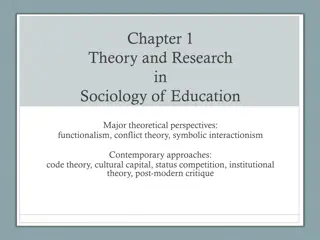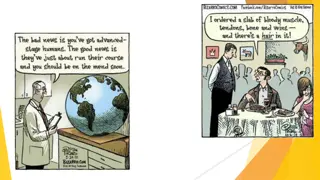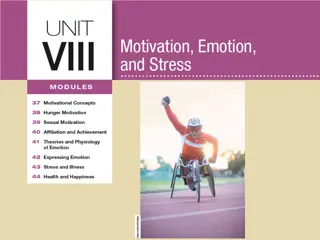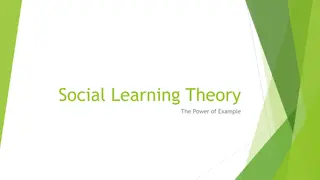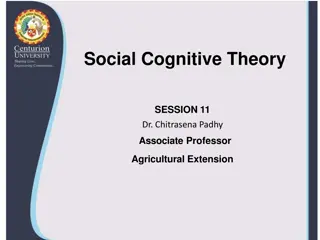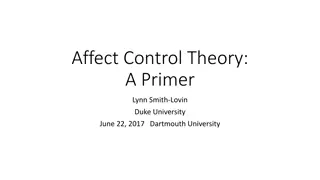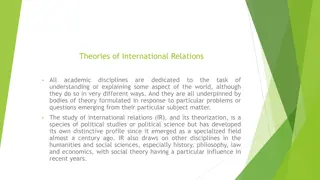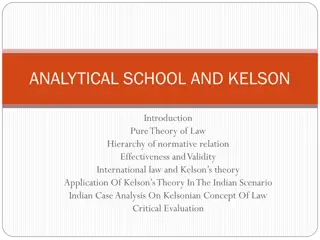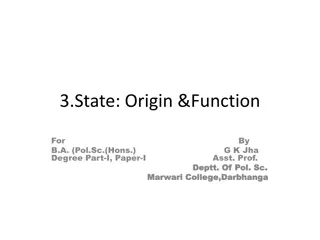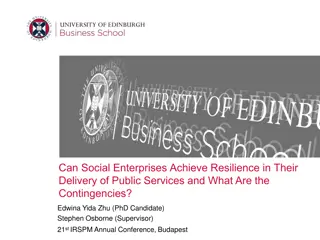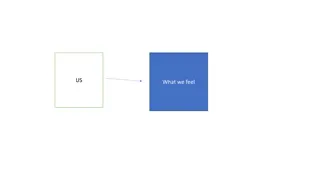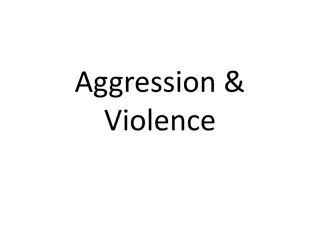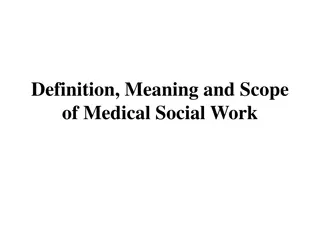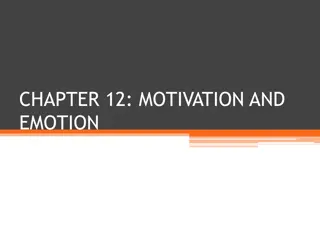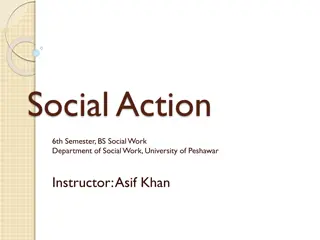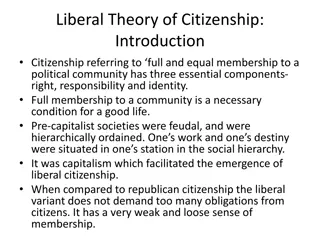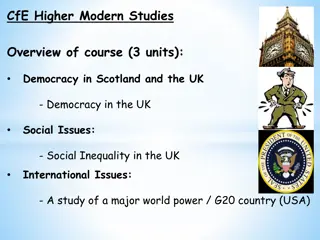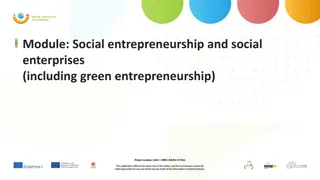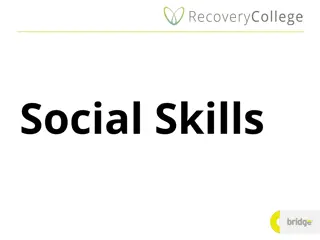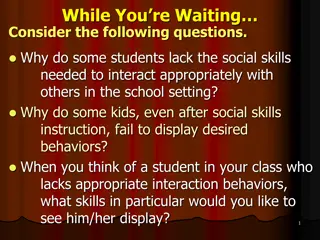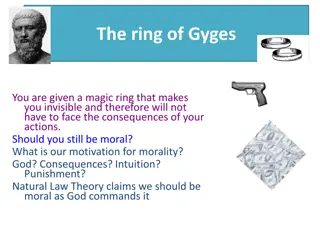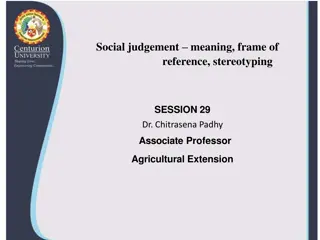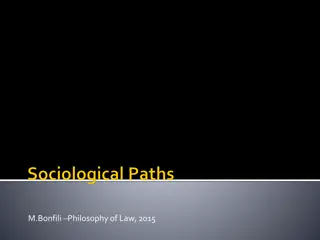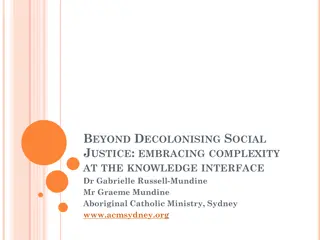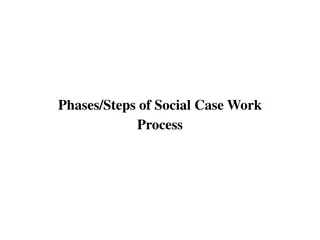Understanding Social Issues through Theory and Perspectives
Social theory is a system of interconnected ideas that organizes knowledge about the social world. It helps us analyze social problems like social pathology, disorganization, conflicts in values, and deviant behaviors. Differentiating theory, perspective, and model, it's key to note that theories provide organized ideas about the world, perspectives express values, and models describe general activities. Theoretical perspectives in sociology offer diverse viewpoints to understand the social world thoroughly, focusing on concepts, relationships, and scope.
Download Presentation

Please find below an Image/Link to download the presentation.
The content on the website is provided AS IS for your information and personal use only. It may not be sold, licensed, or shared on other websites without obtaining consent from the author. Download presentation by click this link. If you encounter any issues during the download, it is possible that the publisher has removed the file from their server.
E N D
Presentation Transcript
Perspektif dalam Menganalisis Masalah Sosial: Patologi Sosial, Disorganisasi Sosial, Konflik Nilai dan Perilaku Menyipang SARI VICIAWATI MACHDUM 10 OKTOBER & 17 OKTOBER 2016
What is Theory? Social theory is a system of interconnected abstraction or ideas that condenses and organizes knowledge about the social world Neuman, 2000. 40
Neuman, 2000. 41 Social theory and ideology Social Theory Ideology Offers absolute certainty Has all the answer Fixed, closed, finished Avoids test... Blind to opposing evidence Locked into specific moral belief Highly partial Has contradiction Rooted in specifuc potition Conditional Incomplete, recognizes uncertainty Growing, open... Welcomes test, positive and negatives evidence Changes based on evidence Detached, disconnected, strong moral stanc Neutral considers all sides Strongly seeks logical consistency Trancends, ...
Neuman, 2000. 41 Similarities Contains a set of assumption or a starting point Explains what the social world is like, how/why it changes Offers a system of concepts/ideas Specifies relationship among concepts, tells what causes what Provides an interconnected system of ideas
Apa beda teori, perspektif dan model? (Payne, 2005, h. 5) A theory is an organized statement of ideas about the world Explanatory theory accounts for why an action results in or causes particular consequences and identifies the circumtances in which it does so Perspectives express values or views of the world which allow participants to order theirminds sufficiently to be able to manage themselves while participating Model describe what happens during practice in a general way, in wide range of situations and in a structured form, so that they extract certain principles and patterns of activity which give practice consistency
The parts of theories (see Neuman!) Concepts Relationship scope
Theoretical Perspectives (Mooney, Knox, and Schacht, 2011, p. 9) Theories in sociology provide us with different perspectives with which to view our social world. A perspective is simply a way of looking at the world. A theory is a set of interrelated propositions or principles designed to answer a question or explain a particular phenomenon; it provides us with a perspective. Sociological theories help us to explain and predict the social world in which we live.
Elements of Social Structure and Culture Social structure : The way society is organized including institutions, social groups, statuses, and roles. Kornblum and Julian, 2012, p.4-5
institution An established and enduring pattern of social relationships.
social group Two or more people who have a common identity, interact, and form a social relationship. Primary groups, which tend to involve small numbers of individuals, are characterized by intimate and informal interaction. Families and friends are examples of primary groups. Secondary groups, which may involve small or large numbers of individuals, are task-oriented and are characterized by impersonal and formal interaction. Examples of secondary groups include employers and their employees and clerks and their customers.
Statuses is a position that a person occupies within a social group. The statuses we occupy largely defi ne our social identity. The statuses in a family may consist of mother, father, stepmother, stepfather, wife, husband, child, and so on. Statuses can be either ascribed or achieved ascribed status Individual has no control. achieved status individual has some control
Roles the set of rights, obligations, and expectations associated with a statuses
Elements of Culture The meanings and ways of life that characterize a society, including beliefs, values, norms, sanctions, and symbols.
? Beliefs refer to defi nitions and explanations about what is assumed to be true. Values are social agreements about what is considered good and bad, right and wrong, desirable and undesirable. A symbol is something that represents something else. Without symbols, we could not communicate with each other or live as social beings.
Malcolm Spector and John Kitsuse (1987) outlined the following major stages (Kornblum and Julian, 2012) Stage 1 Problem definition. Stage 2 Legitimacy. Stage 3 Reemergence of demands. Stage 4 Rejection and institution building.
Three major theoretical perspectives: The structural functionalist perspective, The conflict perspective, The symbolic interactionist perspective. Each perspective offers a variety of explanations about the causes of and possible solutions to social problems. (Kornblum and Julian, 2012)
Kornblum and Julian, 2012, p. 8 Perspective View of Society and Social Problems Origins of Social Problems Proposed Solutions Functionalist Views society as a vast organism whose parts are interrelated; social problems are disruptions of this system. Also holds that problems of social institutions produce patterns of deviance and that institutions must address such patterns through strategic social change. Social expectations fail, creating normlessness, culture conflict, and breakdown. Social problems also result from the impersonal operations of existing institutions, both now and in the past. Engage in research and active intervention to improve social institutions. Create new organizations to address social problems.
Perspective View of Society and Social Problems Views society as marked by conflicts due to inequalities in class, race, ethnicity, gender, age, and other divisions that produce conflicting values. Defines social problems as conditions that do not conform to society s values. Origins of Social Problems Proposed Solutions Conflict Groups with different values and differing amounts of power meet and compete. Build stronger social movements among groups with grievances. The conflicting groups may then engage in negotiations and reach mutual accommodations.
Perspective View of Society and Social Problems Origins of Social Problems Proposed Solutions Interactionist Holds that definitions of deviance or social problems are subjective; separates deviant and nondeviant people not by what they do but by how society reacts to what they do. Society becomes aware that certain behaviors exist and labels them as social problems. Resocialize deviants by increasing their contacts with accepted patterns of behavior; make the social system less rigid. Change the definition of what is considered deviant.
Two dominant theories of social problems grew out of the structural-functionalist perspective: social pathology social disorganization.
social pathology Social Disease This view was rooted in the organic analogy that was popular at the time (In the late 1800s and early 1900s), Human society was seen as analogous to a vast organism, all of whose complex, interrelated parts function together to maintain the health and stability of the whole. Social problems arise when either individuals or social institutions fail to keep pace with changing conditions and thereby disrupt the healthy operation of the social organization; such individuals or institutions are considered sick (Kornblum and Julian, p.9, 2012)
Mooney, Knox, and Schacht, 2011, p. 10 To prevent or solve social problems, members of society must receive.... proper socialization and moral education, which may be accomplished in the family, schools, churches, or workplace and/or through the media.
it is associated with the idea that the poor and other deviant groups are less fit to survive from an evolutionary perspective and hence should not be encouraged to reproduce Do not focus on the behaviors and problems of individuals they see social problems as arising out of the failure of institutions like the family, the schools, and the economy to adapt to changing social conditions. Some sociologists believed the social-pathology viewpoint could not adequately explain the widespread existence of these social problems (mmigration, urbanization, and industrialization increased -> slums, Alcoholism, drug addiction, mental illness, etc).(Kornblum and Julian, 2012, p. 10)
social disorganization (Kornblum and Julian, 2012) A expectations or rules seen to be governing a society fail; it is manifested in three major ways: (1) normlessness (anomie), which arises when people have no rules that tell them how to behave; (2) culture conflict, which occurs when people feel trapped by contradictory rules; and (3) breakdown, which takes place when obedience to a set of rules is not rewarded or is punished. situation that results when the set of
Mooney, Knox, and Schacht, 2011, p. 11 Solutions to teenage drinking may involve strengthening norms against it through public education, restricting media depictions of youth and alcohol, imposing stronger sanctions against the use of fake IDs to purchase alcohol, and educating parents to model moderate and responsible drinking behavior.
Conflict Perspective (Kornblum and Julian, 2012) Rejects the idea that social problems can be corrected by reforming disfunction institutions social problems arise out: major contradictions in the way societies are organized contradictions that lead to large-scale conflict between the have and the have not
Marx (1848, 1867) in the way societies arrange access to wealth and power Capitalism Marx (1848, 1867) Tangdilinting, dkk Perpektif ini dipandang lebih tajam dari pada perspektif patologi sosial, dan lebih fleksibel dari pada disorganisasi sosial Penyebab masalah sosial adalah konflik nilai atau kepentingan
Tangdilinting, dkk Kondisi objektif Merujuk pada kontak dan kompetisi Kondisi Subjektif Mencerminkan perbedaan dalam cara merumuskan dan mengevaluasi kontak dan kompetisi serta pembagian benda dan hak
Tangdilinting, dkk Konflik dapat menjadi sumber ketegangan yang merugikan: Mengorbankan nilai yang lebih penting Konflik dapat menjadi sumber ketegangan yang menguntungkan: menyadari nilai yang seharusnya ada
Tangdilinting, dkk Solusi: Konsensus Pihak yang bertikai memilih nilai yang tertinggi Trade Menegosiasikan penyelesaian Naked power Pihak yang kuat dimenangkan, pihak yang lemah dikalahkan
Perilaku Menyimpang (Tangdilinting, dkk) Salah satu pendekatan untuk memahami masalah sosial Muncul setelah disorganisasi sosial muncul secara dominan (PD II s.d. 50-an) Merton dan Nisbet: Perilaku menyimpang melihat masalah sosial sebagai akibat dari suatu tindakan yang menyimpang dari perangkat nilai yang berkaitan dengan status sosial seseorang Perilaku menyimpang tergantung pada status (contoh, laki- laki yang berperilaku seperti wanita)
Sebutan bagi yang menyimpang: Menyimpang Abnormal Hilang akal Orang asing (outsider)
Brian J. Heraud (1970) Penyimpangan statistic Penyimpangan dari kebiasaan umum sehari-hari (misalnya makan dengan tangan kiri) Penyimpangan medis atau patologis Mempunyai sebab atau akibat sosial atau individual, sehingga perlu di kaji lebih lanjut
Konsep penting Anomie : keadaan kacau tanpa aturan (Durkheim). Bunuh diri Bunuh diri egoistic, Mempunyai ikatan sosial lemah sehingga bunuh diri ketika stress Bunuh diri altruistic Bunuh diri karena ikatan yang kuat terhadap kelompok primer untuk berkorban Bunuh diri anomie Respon terhadap perubahan yang terjadi secara tiba-tiba Alienasi (keterasingan)
Karya ilmiah mendukung (Tangdilinting, dkk) Teori anomie Teori asosiasi deferensial
Tipe Adaptasi Tujuan Budaya Cara Terlembaga Tipe Adaptasi + + konformitas + - inovasi - + ritualisme - - Menarik diri + + memberontak
Karakteristik perilaku menyimpang Masalah sosial didefinisikan sebagai pelanggaran terhadap norma yang dianut oleh masyarakat Penyebab adalah sosialisasi (dari kelompok primer) yang tidak tepat



